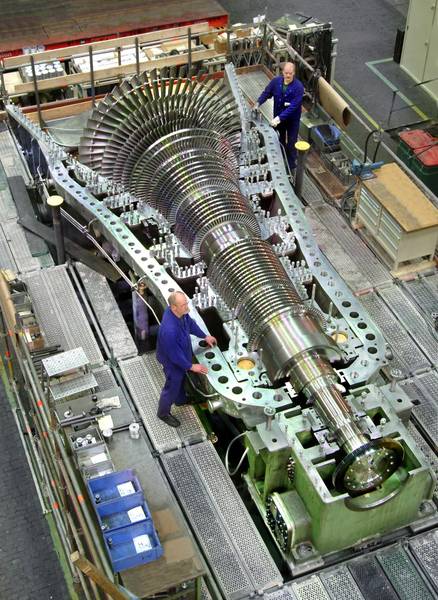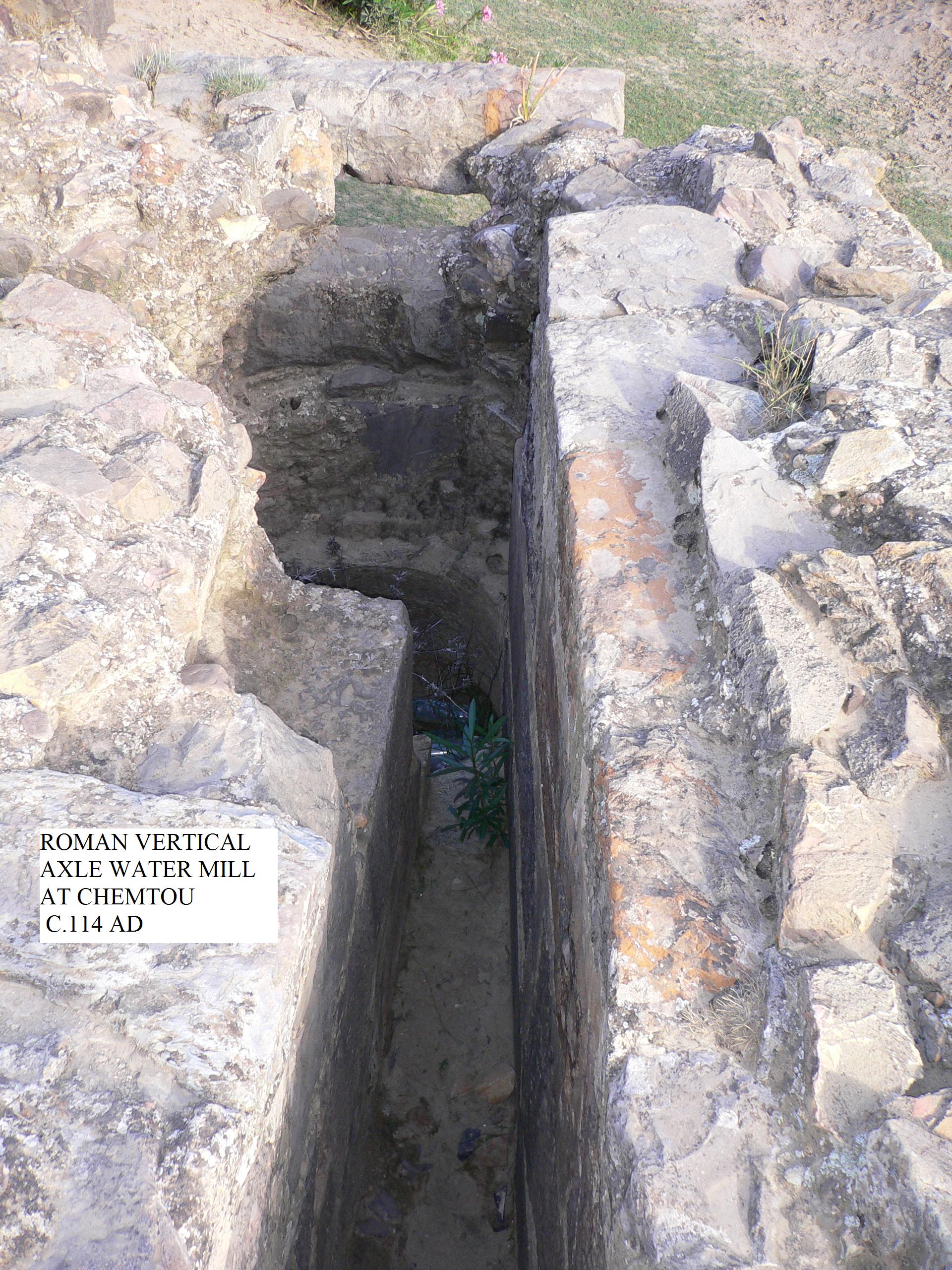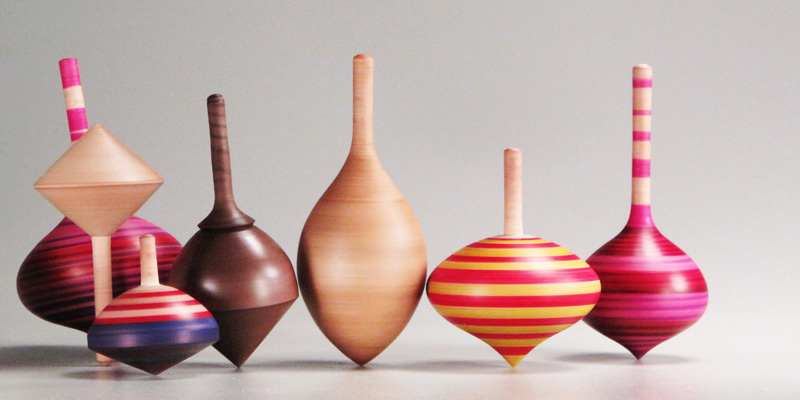|
Turbines
A turbine ( or ) (from the Greek , ''tyrbē'', or Latin ''turbo'', meaning vortex) is a rotary mechanical device that extracts energy from a fluid flow and converts it into useful work. The work produced can be used for generating electrical power when combined with a generator.Munson, Bruce Roy, T. H. Okiishi, and Wade W. Huebsch. "Turbomachines." Fundamentals of Fluid Mechanics. 6th ed. Hoboken, NJ: J. Wiley & Sons, 2009. Print. A turbine is a turbomachine with at least one moving part called a rotor assembly, which is a shaft or drum with blades attached. Moving fluid acts on the blades so that they move and impart rotational energy to the rotor. Gas, steam, and water turbines have a casing around the blades that contains and controls the working fluid. Modern steam turbines frequently employ both reaction and impulse in the same unit, typically varying the degree of reaction and impulse from the blade root to its periphery. History Hero of Alexandria demonstrated ... [...More Info...] [...Related Items...] OR: [Wikipedia] [Google] [Baidu] |
Gas Turbine
A gas turbine or gas turbine engine is a type of Internal combustion engine#Continuous combustion, continuous flow internal combustion engine. The main parts common to all gas turbine engines form the power-producing part (known as the gas generator or core) and are, in the direction of flow: * a rotating gas compressor * a combustor * a compressor-driving turbine. Additional components have to be added to the gas generator to suit its application. Common to all is an air inlet but with different configurations to suit the requirements of marine use, land use or flight at speeds varying from stationary to supersonic. A propelling nozzle is added to produce thrust for flight. An extra turbine is added to drive a propeller (turboprop) or ducted fan (turbofan) to reduce fuel consumption (by increasing propulsive efficiency) at subsonic flight speeds. An extra turbine is also required to drive a helicopter rotor or land-vehicle transmission (turboshaft), marine propeller or electric ... [...More Info...] [...Related Items...] OR: [Wikipedia] [Google] [Baidu] |
Steam Turbine
A steam turbine or steam turbine engine is a machine or heat engine that extracts thermal energy from pressurized steam and uses it to do mechanical work utilising a rotating output shaft. Its modern manifestation was invented by Sir Charles Parsons in 1884. It revolutionized marine propulsion and navigation to a significant extent. Fabrication of a modern steam turbine involves advanced metalwork to form high-grade steel alloys into precision parts using technologies that first became available in the 20th century; continued advances in durability and efficiency of steam turbines remains central to the energy economics of the 21st century. The largest steam turbine ever built is the 1,770 MW Arabelle steam turbine built by Arabelle Solutions (previously GE Steam Power), two units of which will be installed at Hinkley Point C Nuclear Power Station, England. The steam turbine is a form of heat engine that derives much of its improvement in thermodynamic efficiency from the u ... [...More Info...] [...Related Items...] OR: [Wikipedia] [Google] [Baidu] |
Turbomachinery
Turbomachinery, in mechanical engineering, describes machines that transfer energy between a Rotor (electric), rotor and a fluid, including both turbines and gas compressor, compressors. While a turbine transfers energy from a fluid to a rotor, a compressor transfers energy from a rotor to a fluid.Logan, Earl. "Handbook of turbomachinery". 1995. Marcel Deckker.Vandad Talimi (Original author unknown). "Mechanical Equipment and Systems". 2013. Memorial University of Newfoundland. http://www.engr.mun.ca/~yuri/Courses/MechanicalSystems/Turbomachinery.pdf It is an important application of fluid mechanics. These two types of machines are governed by the same basic relationships including Newton's laws of motion, Newton's second law of motion and Euler's pump and turbine equation for compressible fluids. Centrifugal pumps are also turbomachines that transfer energy from a rotor to a fluid, usually a liquid, while turbines and compressors usually work with a gas. History The first tu ... [...More Info...] [...Related Items...] OR: [Wikipedia] [Google] [Baidu] |
Turbines Impulse V Reaction
A turbine ( or ) (from the Greek , ''tyrbē'', or Latin ''turbo'', meaning vortex) is a rotary mechanical device that extracts energy from a fluid flow and converts it into useful work. The work produced can be used for generating electrical power when combined with a generator.Munson, Bruce Roy, T. H. Okiishi, and Wade W. Huebsch. "Turbomachines." Fundamentals of Fluid Mechanics. 6th ed. Hoboken, NJ: J. Wiley & Sons, 2009. Print. A turbine is a turbomachine with at least one moving part called a rotor assembly, which is a shaft or drum with blades attached. Moving fluid acts on the blades so that they move and impart rotational energy to the rotor. Gas, steam, and water turbines have a casing around the blades that contains and controls the working fluid. Modern steam turbines frequently employ both reaction and impulse in the same unit, typically varying the degree of reaction and impulse from the blade root to its periphery. History Hero of Alexandria demonstrated ... [...More Info...] [...Related Items...] OR: [Wikipedia] [Google] [Baidu] |
Water Turbine
A water turbine is a rotary machine that converts kinetic energy and potential energy of water into mechanical work. Water turbines were developed in the 19th century and were widely used for industrial power prior to electrical grids. Now, they are mostly used for electric power generation. Water turbines are mostly found in dams to generate electric power from water potential energy. History Water wheels have been used for hundreds of years for industrial power. Their main shortcoming is size, which limits the flow rate and head (hydraulic), head that can be harnessed. The migration from water wheels to modern turbines took about one hundred years. Development occurred during the Industrial Revolution, using scientific principles and methods. They also made extensive use of new materials and manufacturing methods developed at the time. Swirl The word turbine was introduced by the French engineer Claude Burdin in the early 19th century and is derived from the Greek w ... [...More Info...] [...Related Items...] OR: [Wikipedia] [Google] [Baidu] |
Waterwheel
A water wheel is a machine for converting the kinetic energy of flowing or falling water into useful forms of power, often in a watermill. A water wheel consists of a large wheel (usually constructed from wood or metal), with numerous blades or buckets attached to the outer rim forming the drive mechanism. Water wheels were still in commercial use well into the 20th century, although they are no longer in common use today. Water wheels are used for milling flour in gristmills, grinding wood into pulp for papermaking, hammering wrought iron, machining, ore crushing and pounding fibre for use in the manufacture of cloth. Some water wheels are fed by water from a mill pond, which is formed when a flowing stream is dammed. A channel for the water flowing to or from a water wheel is called a mill race. The race bringing water from the mill pond to the water wheel is a headrace; the one carrying water after it has left the wheel is commonly referred to as a tailrace. Waterwheel ... [...More Info...] [...Related Items...] OR: [Wikipedia] [Google] [Baidu] |
Turbine Blade
A turbine blade is a radial aerofoil mounted in the rim of a turbine disc and which produces a tangential force which rotates a turbine rotor. Each turbine disc has many blades. As such they are used in gas turbine engines and steam turbines. The blades are responsible for extracting energy from the high temperature, high pressure gas produced by the combustor. The turbine blades are often the limiting component of gas turbines. To survive in this difficult environment, turbine blades often use exotic materials like superalloys and many different methods of cooling that can be categorized as internal and external cooling, and thermal barrier coatings. Blade Fatigue (material) ... [...More Info...] [...Related Items...] OR: [Wikipedia] [Google] [Baidu] |
Charles Algernon Parsons
Sir Charles Algernon Parsons (13 June 1854 – 11 February 1931) was an Anglo-Irish mechanical engineer and inventor who designed the modern steam turbine in 1884. His invention revolutionised marine propulsion, and he was also the founder of C. A. Parsons and Company. He worked as an engineer on dynamo and turbine design, and power generation, with great influence in the naval and electrical engineering fields. He also helped develop optical equipment for searchlights and telescopes. Parsons received the Faraday Medal and the Copley Medal for his work. Career and commercial activity Parsons was born into an aristocratic Anglo-Irish family on 13 June 1854 in London as the youngest son of the astronomer William Parsons, 3rd Earl of Rosse. The family seat is Birr Castle, County Offaly, Ireland, and the town of Birr was called Parsonstown, after the family, from 1620 to 1901. With his three brothers, Parsons was educated at home in Ireland by private tutors, including Joh ... [...More Info...] [...Related Items...] OR: [Wikipedia] [Google] [Baidu] |
French Academy Of Sciences
The French Academy of Sciences (, ) is a learned society, founded in 1666 by Louis XIV at the suggestion of Jean-Baptiste Colbert, to encourage and protect the spirit of French Scientific method, scientific research. It was at the forefront of scientific developments in Europe in the 17th and 18th centuries, and is one of the earliest Academy of Sciences, Academies of Sciences. Currently headed by Patrick Flandrin (President of the academy), it is one of the five Academies of the . __TOC__ History The Academy of Sciences traces its origin to Colbert's plan to create a general academy. He chose a small group of scholars who met on 22 December 1666 in the King's library, near the present-day Bibliothèque nationale de France, Bibliothèque Nationale, and thereafter held twice-weekly working meetings there in the two rooms assigned to the group. The first 30 years of the academy's existence were relatively informal, since no statutes had as yet been laid down for the ins ... [...More Info...] [...Related Items...] OR: [Wikipedia] [Google] [Baidu] |
Spinning Top
A spinning top, or simply a top, is a toy with a squat body and a sharp point at the bottom, designed to be rotation, spun on its vertical Axis of rotation, axis, balancing on the tip due to the gyroscopic effect. Once set in motion, a top will usually precession, wobble for a few seconds, spin upright for a while, then start to wobble again with increasing amplitude as it loses energy, and finally tip over and roll on its side. Tops exist in many variations and materials, chiefly wood, metal, and plastic, often with a metal tip. They may be set in motion by twirling a handle with the fingers, by pulling a rope coiled around the body, or through a built-in auger (spiral plunger). Such toys have been used since Classical antiquity, antiquity in solitary or competitive games, where each player tries to keep one's top spinning for as long as possible or achieve some other goal. Some tops have faceted bodies with symbols or inscriptions, and are used like dice to inject randomness ... [...More Info...] [...Related Items...] OR: [Wikipedia] [Google] [Baidu] |






